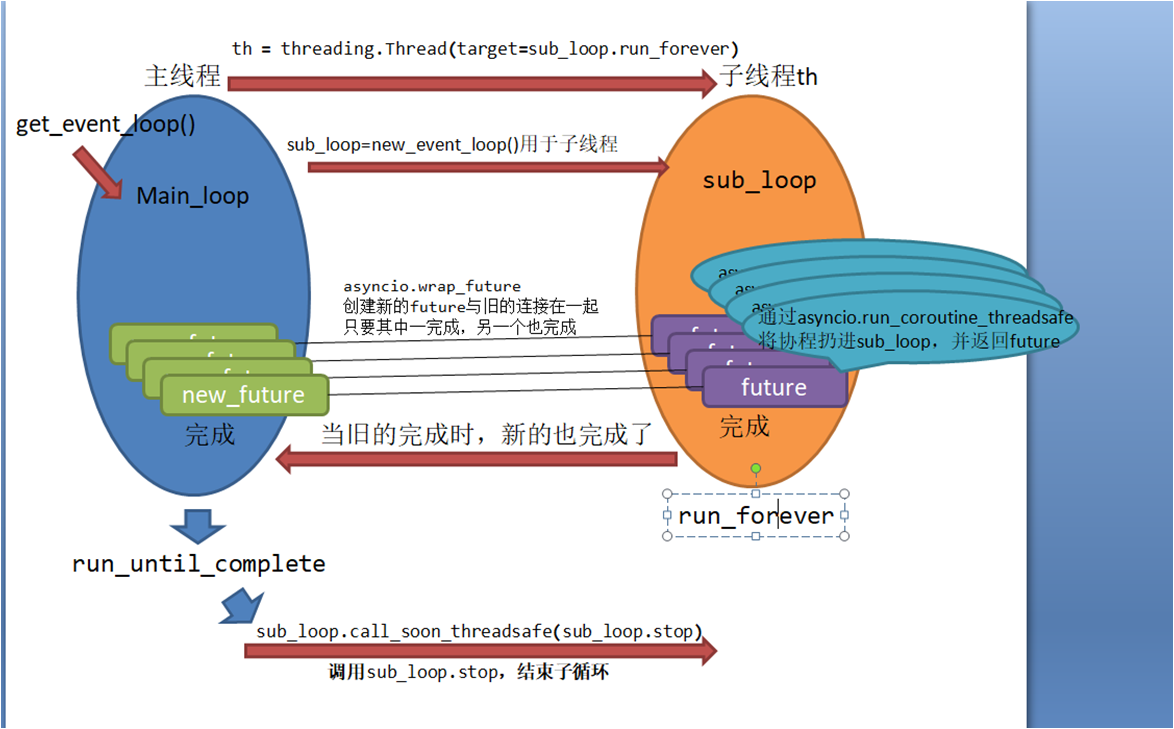aysncio
event_loop
一个线程只有一个event_loop
1、get_event_loop() 只能在主线程中创建event_loop,子线程的loop要在主线程通过new_event_loop创建,然后在子线程中使用set_event_loop来设置,如果 在子线程中直接用get_event_loop创建就会报错
RuntimeError: There is no current event loop in thread 'Thread-1'.
2、new_event_loop(),创建另一个event_loop,与get_event_loop不是同一个。
3、set_event_loop(loop),为线程设置一个event_loop为loop,无返回值.
wait、 gather
gather(*task),以列表返回异步函数的返回结果
wait(task,timeout)可设置超时时间,分别返回的是完成的futures,和未完成的futures,如果要结果,再通过future.result()来获取。
run_coroutine_threadsafe、wrap_future、call_soon_threadsafe
loop.run_until_complete(),任务完成就停止循环
loop.run_forever() ,loop一直运行,直到loop.stop才会停止。loop.close()也不行。
loop.call_soon_threadsafe(),任务完成后调用函数
asyncio.run_coroutine_threadsafe(coroutine,loop),以线程安全的方式运行协程,可实现跨线程调用协程。
asyncio.wrap_future(),创建个新的future与原future连接,只要其中一个完成,另一个也完成。

代码如下
1 main_loop = asyncio.get_event_loop() #主线程 创建主循环 2 sub_loop = asyncio.new_event_loop() #创建另一个新的循环,用于子线程 3 task = [asyncio.wrap_future(asyncio.run_coroutine_threadsafe(do_some_work(i, randint(0,4)),sub_loop)) for i in range(4)]
#创建任务,将异步程序用asyncio.run_coroutine_threadsafe()函数包装成future,再用asyncio.wrap_future包装成新的future,新future会连到主循环中,所以就可以在主循环中使用run_until_complete来等待子循环完成 4 th = threading.Thread(target=sub_loop.run_forever) #创建子线程,启动循环 5 th.start() 6 print("thread",threading.enumerate()) 7 main_loop.run_until_complete(asyncio.wait(task)) #主循环,直到任务完成结束 8 sub_loop.call_soon_threadsafe(sub_loop.stop) #子循环调用stop,停止异步 9 th.join() # 线程结束 10 print("End thread",threading.enumerate())
输出:
thread [<Thread(Thread-1, started 13448)>, <_MainThread(MainThread, started 9788)>] 0 Waiting 1 1 Waiting 3 2 Waiting 4 3 Waiting 0 3 Done after 0s 0 Done after 1s 1 Done after 3s 2 Done after 4s End thread [<_MainThread(MainThread, started 9788)>]
在子线程内开异步:
先上代码:
1 async def do_some_work(i,x): 2 print('{} Waiting {}'.format(i,x)) 3 await asyncio.sleep(x) 4 print('{} Done after {}s'.format(i,x)) 5 return "haha" 6 7 def start_sub_loop(): 8 sub_sub_loop = asyncio.new_event_loop() 9 asyncio.set_event_loop(sub_sub_loop) 10 print("create start_sub_loop threads ", threading.enumerate()) 11 start = now() 12 task = [asyncio.ensure_future(do_some_work(i, randint(0,4))) for i in range(4)] 13 d,p= sub_sub_loop.run_until_complete(asyncio.wait(task)) 14 for i in d: 15 print(i.result()) 16 for i in p: 17 print(i) 18 19 print("cost time:",time.time()-start) 20 print("over threads",threading.enumerate()) 21 def other_thread(): 22 print("create other_thread thread:", threading.enumerate()) 23 t = threading.Thread(target=start_sub_loop) 24 t.start() 25 t.join() 26 print("after t.join() threads ",threading.enumerate()) 27 28 29 th = threading.Thread(target=other_thread) 30 th.start() 31 th.join() 32 print("End thread",threading.enumerate())
输出:
1 create other_thread thread: [<_MainThread(MainThread, started 15288)>, <Thread(Thread-1, started 14816)>] 2 create start_sub_loop threads [<_MainThread(MainThread, started 15288)>, <Thread(Thread-1, started 14816)>, <Thread(Thread-2, started 15252)>] 3 0 Waiting 3 4 1 Waiting 1 5 2 Waiting 0 6 3 Waiting 0 7 2 Done after 0s 8 3 Done after 0s 9 1 Done after 1s 10 0 Done after 3s 11 haha 12 haha 13 haha 14 haha 15 cost time: 3.000324249267578 16 over threads [<_MainThread(MainThread, started 15288)>, <Thread(Thread-1, started 14816)>, <Thread(Thread-2, started 15252)>] 17 after t.join() threads [<_MainThread(MainThread, started 15288)>, <Thread(Thread-1, started 14816)>] 18 End thread [<_MainThread(MainThread, started 15288)>]
上面代码共开了三个线程,只在最后一个线程开协程。其实和在主线程开协程一样,不同的是在主线程可以用get_event_loop,在子线程只能用new_event_loop,和set_event_loo。



 浙公网安备 33010602011771号
浙公网安备 33010602011771号